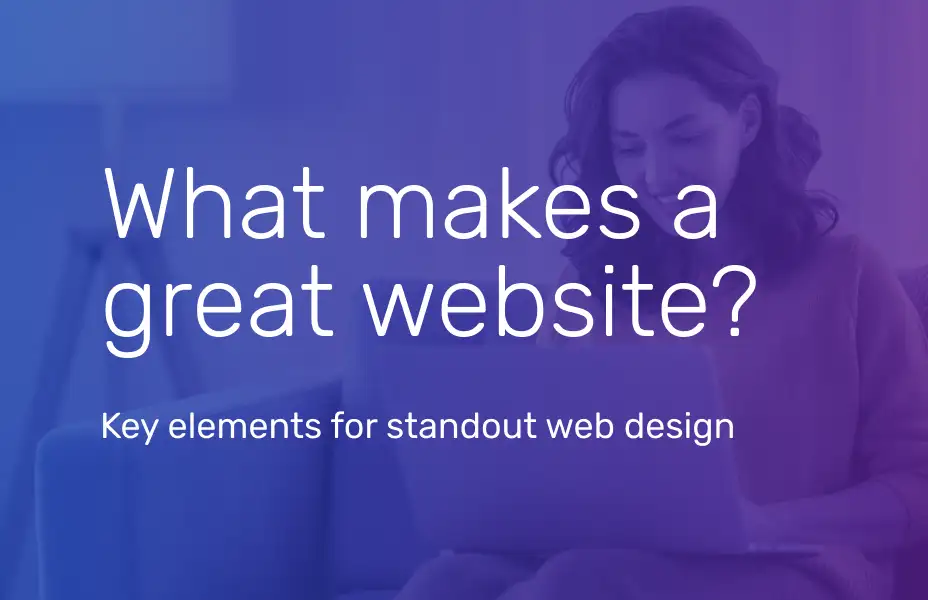What Makes a Great Website?

Our team is always keeping an eye out for websites that really grab our attention. Which got us thinking, just what makes a great website?
A great website is not just a luxury; it is a determining factor in cementing a customer's first impression of your business. With competition just a click away, creating a website that stands out is not just desirable; it is essential. But what exactly makes a website great? It is not just about flashy design or the latest technology, although they have their importance. A great website is purposeful, user-centric, fast, responsive, and content-rich, guiding visitors effortlessly toward the actions you want them to take. In part one of our series, let us start with why purpose is so important.
Have a clear purpose
Every great website has a clear purpose. When websites try to do too much, visitors get confused and leave. Great websites focus on one primary goal at a time, whether it is selling a product, generating leads, or providing quality information. Clarity in purpose keeps users engaged and guides them to act. Take the New Yorker homepage, for example. Its homepage has two main purposes: to engage with thought-provoking content and to make you a subscriber.
Superb web design
A superbly designed website is crucial because it serves as your storefront, shaping first impressions and influencing your customers’ behaviour. A well-designed website enhances credibility and professionalism and significantly improves user experience by offering intuitive navigation, fast loading times, and mobile responsiveness. It drives engagement by presenting content in a visually appealing and easily digestible manner, leading to higher conversion rates.
Take Apple, for example, whose minimalist design is clean, spacious and offers its users intuitive navigation and high-quality images, to highlight the best of what they have to offer, or Slack, with its vibrant colour palette, user-friendly layout, and playful illustrations. Nike’s website is another one that has caught our attention, combining bold imagery with a dynamic, interactive design that reflects the brand's energy. The other one is the New York Times’ website, which offers its users an excellent example of balancing content-heavy pages with a clean, organised design.
A powerful CMS
Over the past few weeks, we have discussed the power and advantages of a powerful Content Management System (CMS). Behind every great website is a CMS that is the oil in the machinery. From Sitefinity to Sitecore or WordPress, choosing the right CMS to power your great website is not an easy choice. Each platform has pros and cons, but you must pick a platform that allows you to customise your website and turn it into an absolute powerhouse. Great websites have immensely powerful CMS platforms behind them.
Relevant content
Content has always been king. High-quality, relevant content keeps users on your site longer and encourages them to return. A great website has consistency in tone and style and frequently updates its content to keep the site relevant and users engaged. Steps to consider: Develop a content strategy that outlines the type of content you should be producing, how often you will publish, and the voice you will use. Then, create a content calendar to update your content and keep it fresh and relevant.
Strong calls to action
A great website guides users toward taking specific actions. The mistake many make is burying their calls to action (CTAs) or making them too vague. Successful websites have clear, prominent CTAs that tell users exactly what to do next.
Accessibility
Accessibility is the backbone of a great website. It ensures all users, including those with disabilities, can access and interact with the content. This broadens the audience by making the site usable for everyone, improves the overall user experience, and aligns with legal and ethical standards. Prioritising accessibility reflects a commitment to inclusivity and can enhance a website's reputation and reach. Take the Microsoft website as an example. The site contains clear navigation, keyboard-friendly interfaces, and extensive accessibility support.
Speed & performance
Speed matters. A slow website frustrates users and leads to high bounce rates. Research shows that 40% of users abandon a website that takes more than 3 seconds to load. To improve load times, compress images, use a content delivery network (CDN), and minimise the use of heavy scripts.